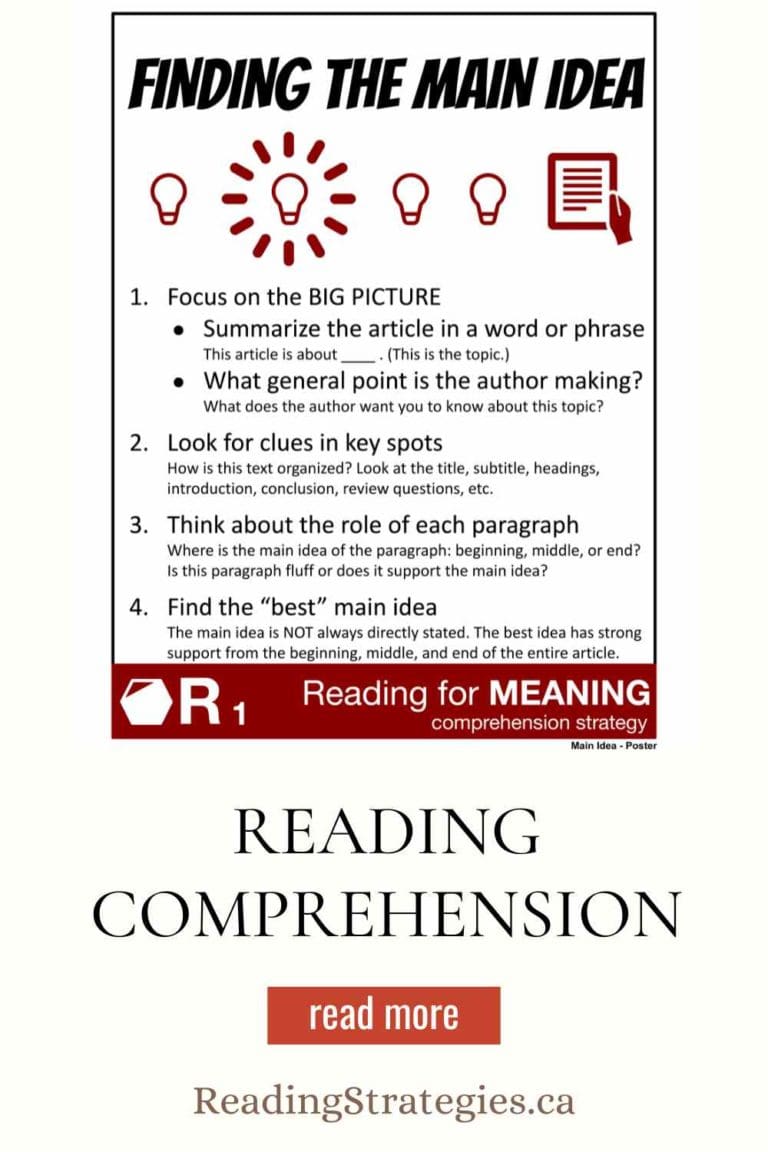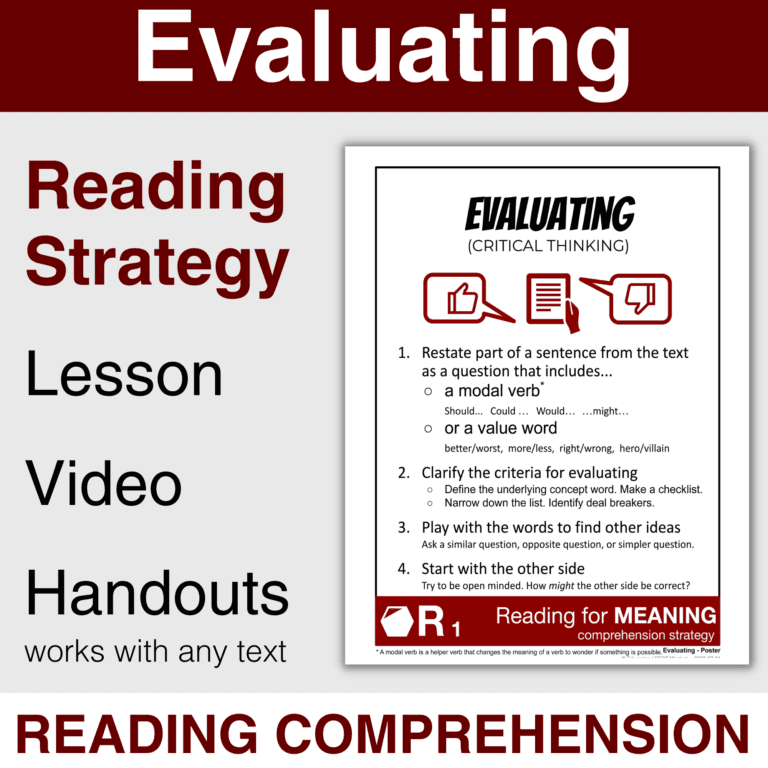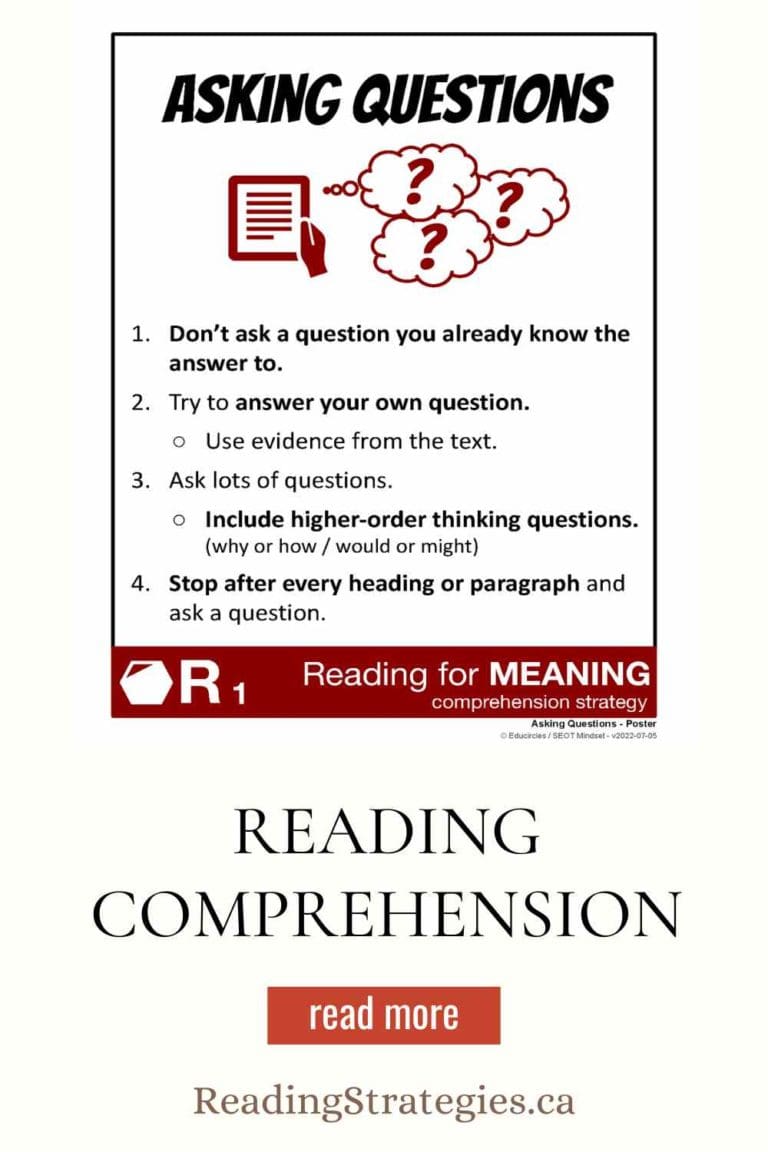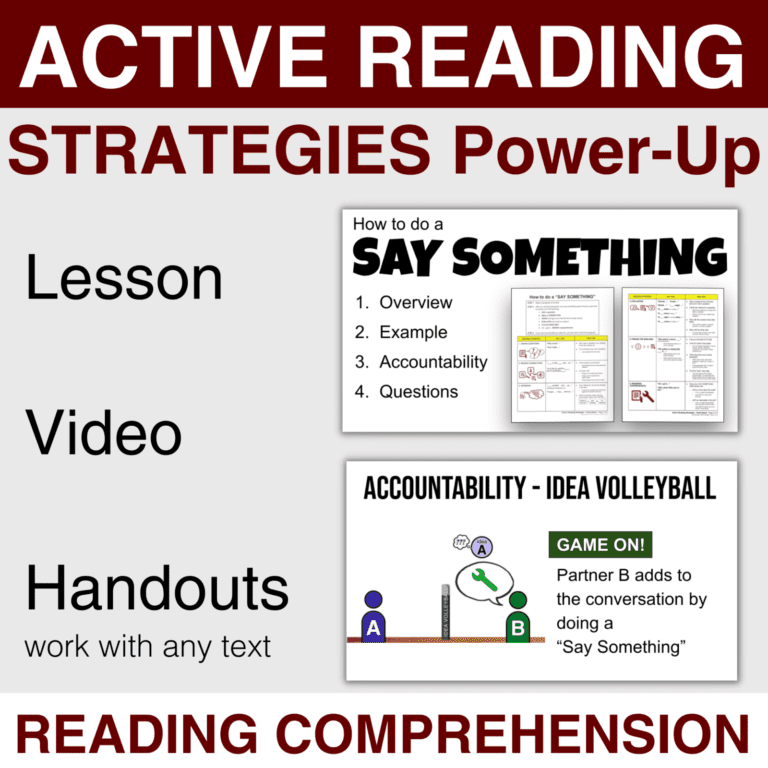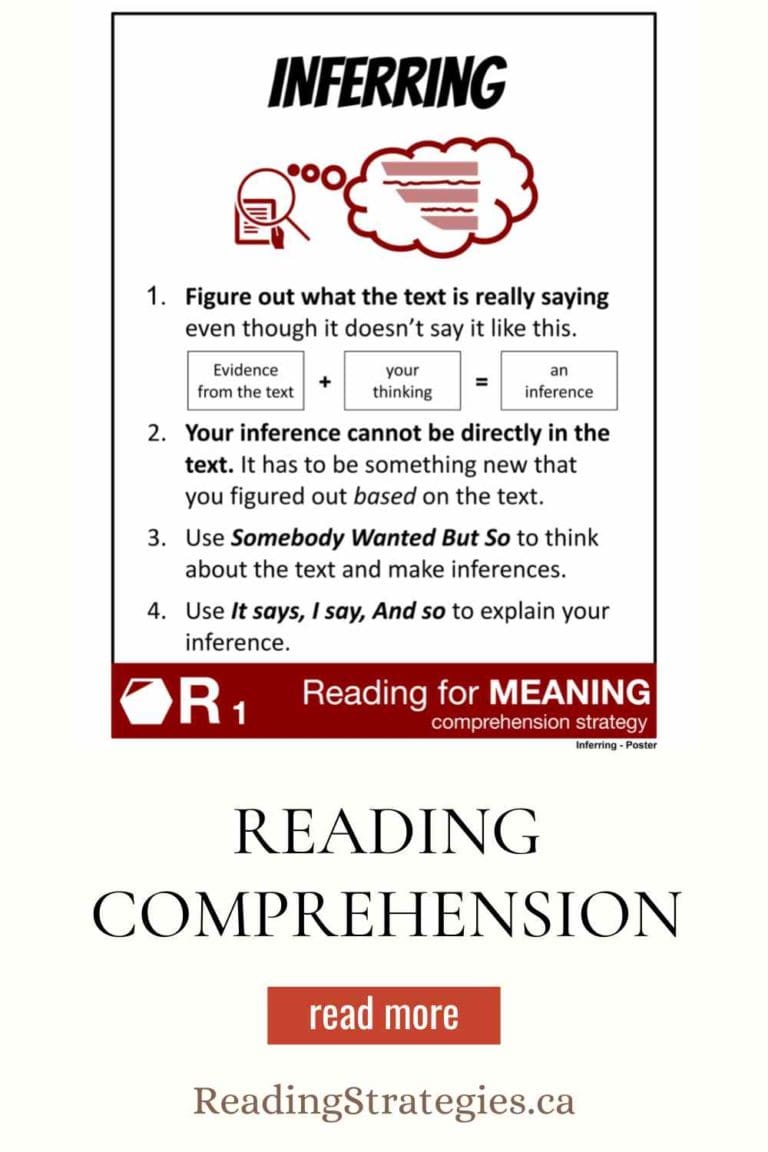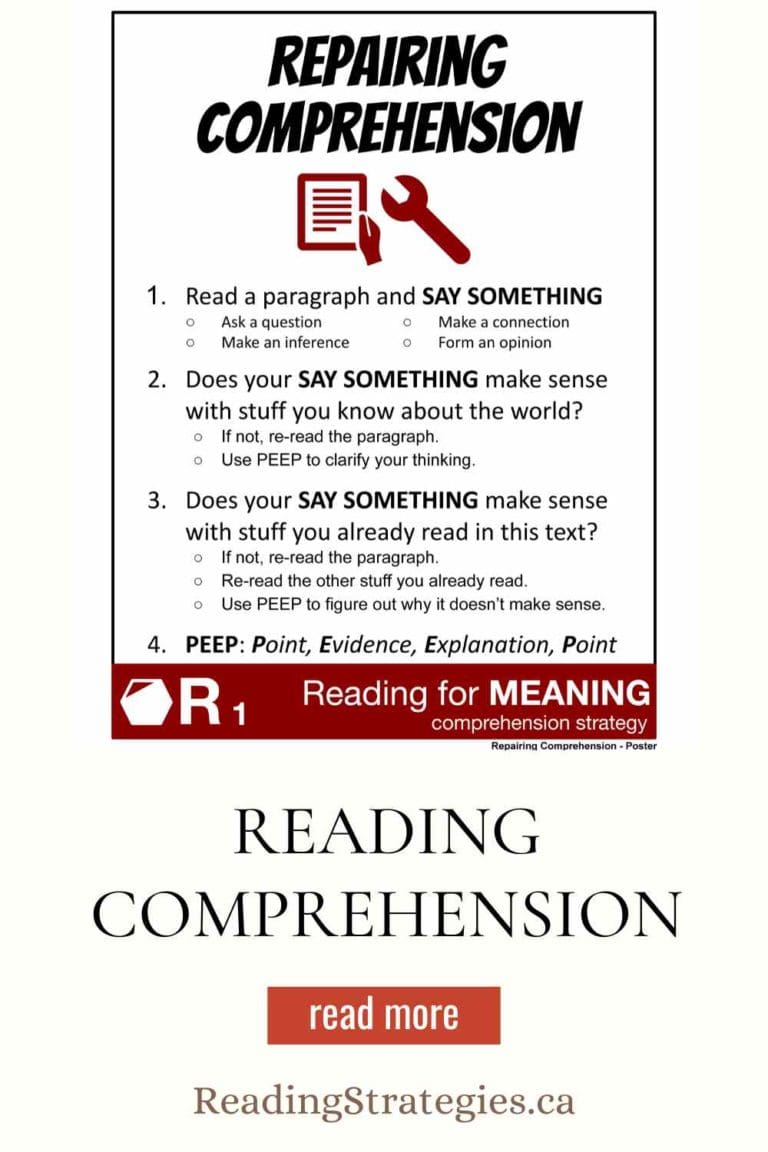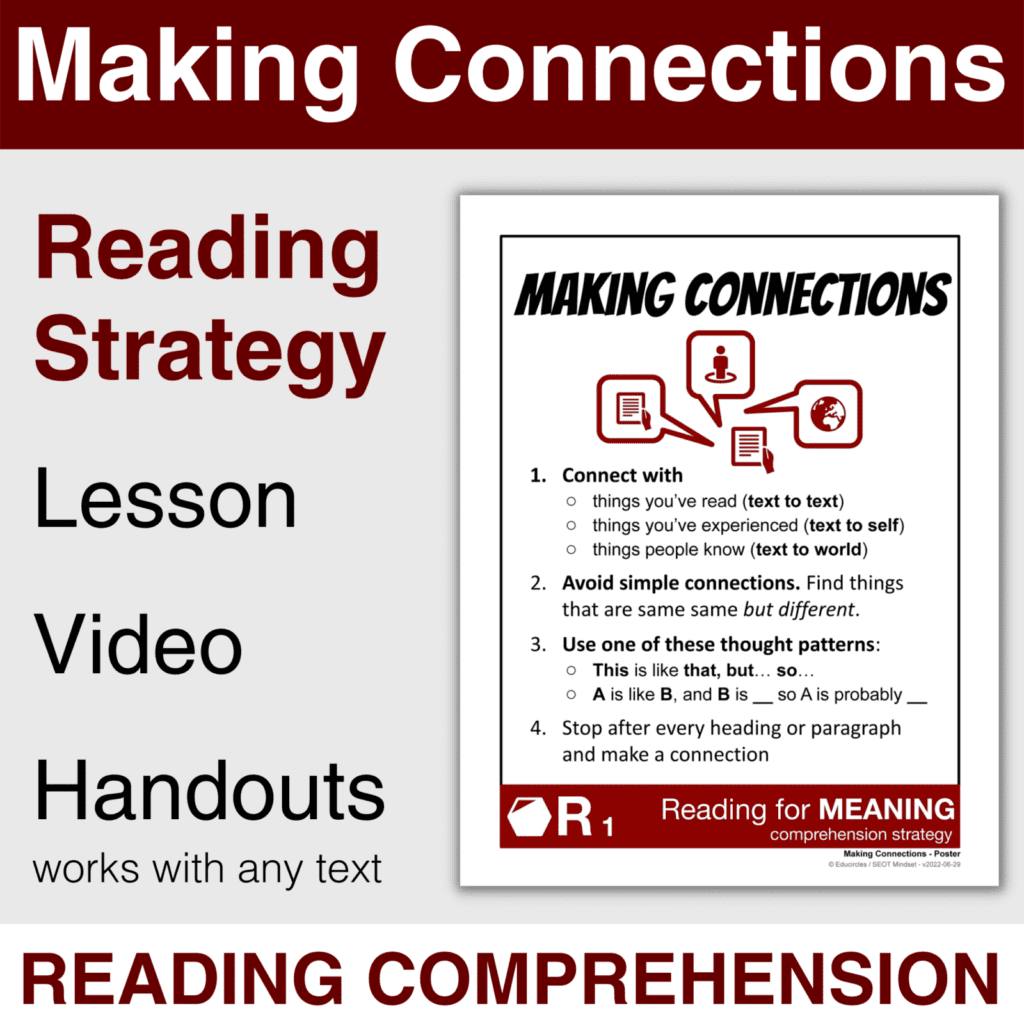
Making Connections Lesson Plan – Reading Strategy UPDATE Mar 21, 2023
Making Connections is more than simply finding any text-to-text, text-to-self, or text-to-world connection.
Use this lesson to help your students develop deeper connections instead of thin connections like “this book has a dog and I have a dog…”
MAKING CONNECTIONS
Reading Strategy
How to Make (Deeper) Connections – 4 PRO TIPS
- Connect with things you’ve read (text to text), things you’ve experienced (text to self), or things people know (text to world)
- Avoid simple connections. Find things that are same-same but different.
- Use one of these thought patterns:
○ This is like that, but… so…
○ A is like B, and B is _ so A is probably _ - Stop after every heading or paragraph and make a connection
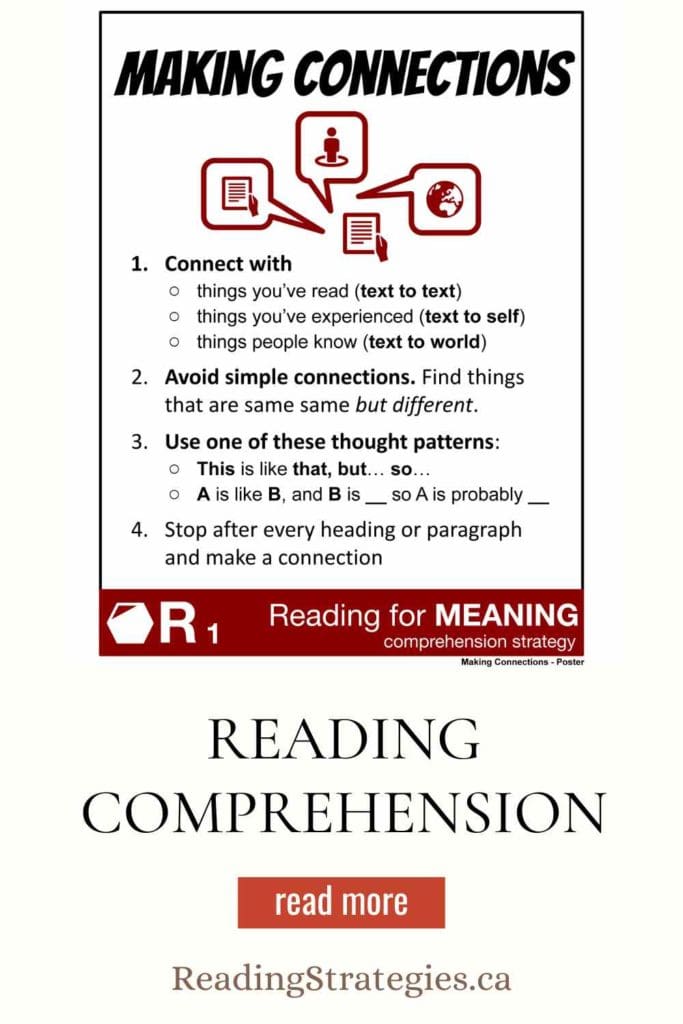
The slideshow lesson is comprehensive, easy to use and includes everything you need for :
- DISTANCE LEARNING or 1:1 LEARNING in Google Classroom
- FACE to FACE LEARNING in your real classroom
In this package, you get:
- the slideshow lesson to walk your students through 4 tips to using the Making Connections strategy, an example of how to use this strategy and how this strategy connects with active reading and 21st century learning skills.
- a generic Making Connections handout package that can be used with any text. This helps students ask questions before, during, and after reading.
- a metacognition handout/reflection questions to help students reflect on the strategy
- a rubric to assess ideas generated during reading, as well as ideas generated during the metacognition reflection.
BONUS VIDEO LESSON:
- I’ve recorded the slideshow as a FREE YOUTUBE VIDEO so it’s easier to teach with DISTANCE LEARNING: https://youtu.be/mC71vCiv9Ok
IMPORTANT NOTE: This product DOES NOT include a text for students to read!
The package only includes the Making Connections strategy slideshow lesson and handouts.
It is intended for teachers to use with a novel or text that they are studying in class.
Reading comprehension strategies like Making Connections help students engage with the text and gain a deeper understanding than just passively reading.
If you want this product with reading texts, please check out our Reading for Meaning Comprehension Strategies bundle.
Watch the FREE Reading Comprehension Video.
FREE Video of the Making Connections Reading Comprehension Lesson Plan
Here’s the YouTube link
Hi everyone, it’s Mike from Educircles and as part of our Reading for Meaning series, we’re going to take a look at the Making Connections reading comprehension strategy.
Before we start the mini-lesson, let’s just turn our minds on.
- We’re going to be doing some active reading which means we think about the text as we read.
- Your brain should be getting a workout.
- Remember, it doesn’t matter if you’re great at reading or if you struggle – at some point we all read something we don’t get right away.
- Using comprehension strategies help us figure out the text and become stronger readers.
There are lots of different comprehension strategies – the one we’re going to look at right now is called Making Connections.
The goal of Making Connections is to develop a deeper understanding of the text we are reading.
Usually, when we talk about Making Connections, we talk about 3 different types of connections: text to text, text to self, and text to world.
But let’s take a step back here and forget about reading for a moment.
Making Connections isn’t just a reading strategy. It’s something we do all the time naturally. It’s about figuring things out by comparing things to stuff we already understand. We do this all the time.
Using the Making Connections Reading Strategy in real-life! Let’s look at some photos.
As you look at this series of images, describe everything you see and say something about each item – try to explain or guess how each item is used.
Okay, so check out this photo – describe everything you see
You might say something like:
- I see a circular photo
- It looks like a metal faucet with a lever on top
- There’s some sort of metal ring or hole
- It looks like maybe a white porcelain sink
- I see brown squares on the wall in the background
Okay, now let’s break it down and explain what the objects are:
- So, that’s a faucet and you probably turn the tap to the left to get hot water and to the right to get cold water.
- That metal circular ring is probably a drain so the water doesn’t overflow
- The white porcelain container is a sink so that you can store water and wash stuff
- The brown squares in the background are tiles which are easier to clean than just regular painted walls in your house. Maybe this is a sink in a school bathroom? It’s probably not a kitchen because you don’t have white sinks like that in your kitchen.
Here’s the next image – what else can we see as we zoom out?
- I can see the other wall of the white porcelain basin
- I can see a reflection in the tap so maybe it was cleaned recently and that’s why it’s shiny?
- I can see the outside of the sink – it doesn’t look as shiny.
- I see flat rectangles beside the metal tap – maybe that’s where you put the soap dish to wash your hands?
What about now in this photo
- We can see the circle is even bigger
- We can see more of the room and it looks like there’s another sink with a white lid or cover – or maybe that’s a top-loading washing machine? No, it’s too small.
- The sink looks pretty narrow – we can see the floor so this is probably pretty small – maybe it’s a tiny bathtub?
- Maybe the sink is actually another toilet and you use the sink to flush things down? Ugh….wouldn’t that be gross?
- There are whitish-grey rectangles at the back of the two white sink thingies
- Maybe this is where you wash small things in the sink – because the sink is so tiny?
- It looks like it’s on the floor, so maybe it’s for dogs to get a drink (instead of drinking from the toilet)
- maybe the white rectangles are sensors – you move your hand over and something happens but I’m not sure why you would have a sensor if you already have a lever on top of the faucet.
What about now? Describe what you see and what the objects are for now that you can see the whole photo.
Let’s especially focus on these four items.
- It looks like there’s a toilet paper roll holder – it’s made out of metal and is not holding anything right now
- it’s right by the toilets and was easier to reach after you’re done with your business.
- at the bottom, there looks like there is a toilet brush inside that metal cylindrical holder and that’s for when you need to clean the toilet – you just hold it by the stick part and then on the other end of the stick, there are those bristles and you can clean the inside of the toilet bowl – get the grime that goes underneath the ledge of the toilet kind of like a toothbrush.
That’s probably a toilet
- it’s used to get rid of body waste – so somehow you flush that toilet and then a bunch of water goes down the bowl to flush everything down the pipes… but usually there’s this back part that stores all of the water you use to flush – so I’m not sure how that thing flushes.
Okay, so we have a really small sink here.
- It’s about the size of the toilet – it’s right beside the toilet –
- it’s close by, like the toilet paper roll so maybe you’re supposed to wash your hands as you use the toilet but I don’t know why the sink would be so low for your hands – wouldn’t that be awkward to use if you were standing up? And wouldn’t it be awkward to use it from the side like that if you were sitting on the toilet? Why not put the tap on the opposite side of the toilet so that when you’re sitting on the toilet, the sink is facing you?
- There’s no toilet paper in this picture so maybe this is a photo of a bathroom on display in a store?
It’s a bidet? What’s a bidet?
- maybe the bidet is close to the toilet because it’s supposed to be used like toilet paper, right?
- you put the toilet paper roll holder close to the toilet because you need it when you’re done your business on the toilet
- maybe a bidet is like a sink for your feet but why would you put it near the toilet instead of near the shower?
- maybe a bidet is like a sink for your butt but how would you wash your… gasp!
So think back to some of the things you thought as we looked at the photo:
You probably said things like:
- it looks like … but why would you ….
- or maybe it’s kind of like …. but instead of … you
- Or, maybe you had an aha moment when you realized how you use a bidet
There’s a wide range of reactions you might have.
The point of Making Connections is to try to create an ah-ha moment and figure out something that you didn’t get before.
- At first, most people who live in countries where bidets are not very common might think it was a sink because of the tap in the photo
- But then you start to realize it couldn’t be a sink because it’s so low to the ground
- So that’s when we start thinking about what else the bidet could be used for
- and then a spark happens when we figure out that you use water (instead of toilet paper) to clean your body after you use the bathroom
- and that’s a new understanding for some of us because, in the beginning, we thought it was a sink.
So let’s watch a 30 second clip of a media text about bidets. As you watch this video see if you can connect it to something you’ve read, something you know or have experienced, or something general that people just know
Tech Insider does a great job in this video making a comparison to show people why you would want to use more than just paper to clean up poop.
Text-to-Text Making Connections Example
An example of a text to text connection might be something like this:
One time, I read this short story, Boys, Beer, Barf and Bonding by Bruce Hale, and in it, there’s this moment where the dad and the kid come back from camping and they have really upset stomachs. They’re locked out of the house and they “erupt from both ends” because they couldn’t get to the bathroom in time!
Ughhh! I bet cleaning up that mess would need a lot more than toilet paper…
Text-to-Self Making Connections Example
Here’s an example of a text-to-self connection:
- one time my cat pooped outside of his litter box and I accidentally stepped in it.
- Ugh. It was gross.
- So I put my foot in the sink and used a lot of soap to wash it off. I don’t know why I was standing on one leg at the sink when the bath tub was so close by, but I just wasn’t thinking…
Text-to-World Making Connections Example
Here’s an example of a text-to-world connection which can be a connection to something that’s happening in the world or it could be just general knowledge that everyone knows
- For example, everybody poops – we know this because living creatures need to get rid of body waste
- We also know that toilets come in different shapes and styles because we’ve used a bunch of toilets in our lives.
Let’s bring this back to Reading Strategies
Making Connections is really about figuring stuff out and we do this all the time.
But sometimes, when we talk about reading strategies or school stuff, some of us get bored or we think I don’t get it or I don’t want to.
But, understand that we make connections all the time. We do this automatically. And it’s a transferable skill. So let’s see how making connections can help us develop a deeper understanding of the text we are reading.
Remember: the goal here is to try to create these ah-ha moments so you can figure out new stuff about the text you are reading.
- When we connect what we’re reading to something we’ve already read, we call that a text to text connection.
- When you connect the text to something you personally know or have experienced, we call that a text to self connection
- When you can connect the text to something happening in the world, or something general that people know, we call this a text to world connection
Making Connections is a reading strategy we use
- before we read
- as we read, and
- after we read.
So, basically, all the time.
Here are 4 Pro Tips to help you get more out of the Making Connections Reading Strategy
Making Connections Reading Strategy – PRO TIP #1: Connect the text you’re reading to something that you know personally
Basically you’re just trying to relate to what you are reading so that the text means more to you.
This could be a text to text, or text to self, or text to world connection.
So, yeah, connect what you’re reading to pretty much anything.
Making Connections Reading Strategy – PRO TIP #2: Try to avoid simple or straightforward connections
A lot of times, students stop with these really thin connections that don’t give us any new insight into what we’re reading. That’s because thin connections are just too simple.
- For example: this story has a dog and I have a dog
A more ridiculous example might be something like this:
- This story uses the letter “a” and I’ve read a story that used that same letter!
Well, knowing that a story uses the same letter doesn’t really help us understand the text we’re reading any better because the connection is just too simple.
We can make connections more complex by trying to find connections that are “same same, but different”
An example of a more complex connection would be something like this:
- This story has a dog, and the dog changes the old lady’s life.
- I don’t have a dog but when I got glasses, I could finally read the board and I guess that kind of changed my life, too.
In this example, a dog is different from getting glasses, but they’re both kind of the same since both of them change people’s lives
In fact to take it one step further, we could say that getting glasses made the student’s life better because they can now see the board from the back of the room.
So then maybe, the dog somehow makes the old lady’s life better because maybe the dog helps the lady do something that she couldn’t do before…
Making Connections Reading Strategy – PRO TIP #3:
Use one of these sentence patterns to turn your connection into a deeper idea
- this is like that, but… so… or
- A is like B and B is blank so A is probably blank as well…
Let’s go through a few connection examples to see how to use these sentence stems:
If we think back to our bidet example:
- A bidet is like a sink but it’s at ground level so it’s easier to clean your lower body parts with water
Text to World Connections – Example #1
Here’s another connection example:
- a bidet is like toilet paper but instead of using paper, you use water to wipe so you get cleaner
Text to World Connections – Example #2
Here’s an example for the second thought pattern: A is like B. B is blank so A is probably blank…
- A bidet is like a sink. A sink can be used to wash body parts, so a bidet might also be used to wash body parts.
Text to World Connections – Example #3
Here’s another example:
- A bidet is like a shower. A shower can get you cleaner than just wiping with paper, so maybe a bidet can get you cleaner because it uses water.
Pro tip #4 Stop after every heading or paragraph that you read and make a connection
- If you don’t get what you are reading, then you might want to stop after every sentence
- on the other hand, if you’re not struggling then maybe don’t stop as often – but remember that strong readers are constantly connecting ideas and thinking about things as they read
Alright. Time to Practice Making Connections!
Here’s a screenshot of the beginning of an informational text.
Let’s use the Making Connections reading strategy as we go through this article
- The first thing we have to do is stop after every heading or paragraph to make a connection.
- Most of us gloss over titles and headings but the titles and headings give us important clues about how an informational text is organized.
- They give us clues about what we’re going to read next
When we read, just connect the text to anything – text to text, text to self or text to world
- so, for example, this reminds me of the part before the TV episode where they recap what happened last time.
Try to use a sentence pattern to develop your connection into a deeper idea.
- For example, I’m going to use the sentence pattern, A is like B. B is blank, so A is probably blank.
- The background information section is like when they tell you what happened last time in a TV two-part episode. The recap focuses on the key information you need for the second episode to make sense so maybe this part of the text I’m reading will focus on key information I need to know for the article to make sense.
Double check that your connection is not a simple connection. Make sure your connection is same same, but different.
- For example, the two things I’m comparing are different because I’m comparing the title of the section, “background information” to the recap on TV episodes that are two-parters. (They don’t say, “background information” at the beginning of the episode.)
- But, they’re kind of the same because they both give me key information that I’m going to need for this to make sense.
Okay. More practice time. This time, it’s your turn:
What do we do next?
- (SILENT ANSWER):
- stop after every heading or paragraph and make a connection
So, I’m going to read this first paragraph and you think in your head about possible connections.
SOURCE: Rosa Parks: Quiet Courage in Communication (Article 005)
- In 1955, the buses in Montgomery Alabama were segregated based on the colour of your skin. Only people who were White could sit in the first four rows of seats. People who were Black would pay their fair at the front. Then, they would have to get off the bus and board again through the back doors to find a seat.
What are the 3 types of connections we could make?
- (SILENT ANSWER)
- text to text, text to self, or text to world
So, in your head, you’re saying things like, “this reminds me of…” and then finish that sentence.
At this point, when we’re reading, you don’t have to come up with a complex idea. We’re just trying to make connections.
If you can’t make a connection, you need to re-read that paragraph to come up with something to say.
Is there anything in this paragraph that reminds you of something that happened
- in a book you read?
- or something that you personally experienced?
- or something that’s happening in the world or something that’s common knowledge?
Pause the video and come up with a few personal connections.
Okay, we’re back.
Once you have a bunch of connections, choose one for the next step.
What do we do next?
- (SILENT ANSWER)
- Use a sentence pattern to develop a deeper idea
What are the two different sentence patterns we talked about in this video?
- A is like B. B is blank so A is blank, or
- you can use the sentence pattern: this is like that, but, so
What do we do next when we’re using the Making Connections reading strategy?
- (SILENT ANSWER)
- Make sure we avoid simple connections
- We do this by making sure our connections are same same but different.
So, if you write things down in a graphic organizer,
- the two things that you’re comparing should be different
- but the reasons and thinking part afterwards should be the same – they should be connected because we make connections try to understand things better in the text
Let’s summarize this Making Connections Lesson Plan
Here are 4 things you can do to make great connections:
- Connect what you’re reading to anything in your background knowledge:
- things you’ve read (TEXT-to-TEXT)
- things you’ve experienced (TEXT-to-SELF)
- or things that are happening in the world or things that people just know. (TEXT-to-WORLD)
- Avoid making simple connections.
- We do this by trying to find things that are same-same but different
- Use one of the following sentence-frames to help you develop more complex ideas:
- this is like that, but… so… or
- A is like B and B is blank, so A is probably blank.
- Finally, stop after every heading or paragraph and make a connection
PART 3
Reading for Meaning is just part of the many strategies and skills that we use when we read.
The world is unpredictable. Reading is an important thing to be able to do to survive and thrive in today’s changing world.
We need strength of character to have grit and resilience to keep going when things get tough.
One way to work on character is to consciously choose to be in a growth mindset. This means understanding that if we use specific strategies, if we work hard, if we learn from our mistakes, then we can persevere and pick ourselves up when things get tough..
The Making Connections Reading Strategy is more than just a reading strategy. It’s a transferable skill that can help us at school and in life
It’s something we use across 21st-century competencies.
- We make connections when we realize that the strategies we use in reading or at school can also be applied to other parts of our life – it all has to do with having a growth mindset and developing character, perseverance and tenacity.
- We make connections when we relate to other groups of people in our community and notice the similarities we have but also appreciate and acknowledge the differences.
- We make connections when we collaborate in groups and we compare ideas to create new understandings that help us achieve a common goal.
- We make connections when we communicate and relate to the other person’s perspective – if we can recognize differences in how we communicate and interpret things, we can modify our communication style to help get our message across more clearly
- We make connections when we relate different ideas from one area of our life to another. This is how we innovate – by creating new ideas based on things we’ve read, our personal experiences, and our understanding of the world.
- Finally, we make connections when we recognize how our view of the world is connected to our life experiences, our culture, the way we grow up … and that affects our unconscious bias and emotional bias that sometimes gets in the way of critical thinking.
END
Well, that’s the end of this video.
Teachers – if you’re looking for the slideshow or handouts that go with this Making Connections Lesson Plan, please click here.
See you next time!
